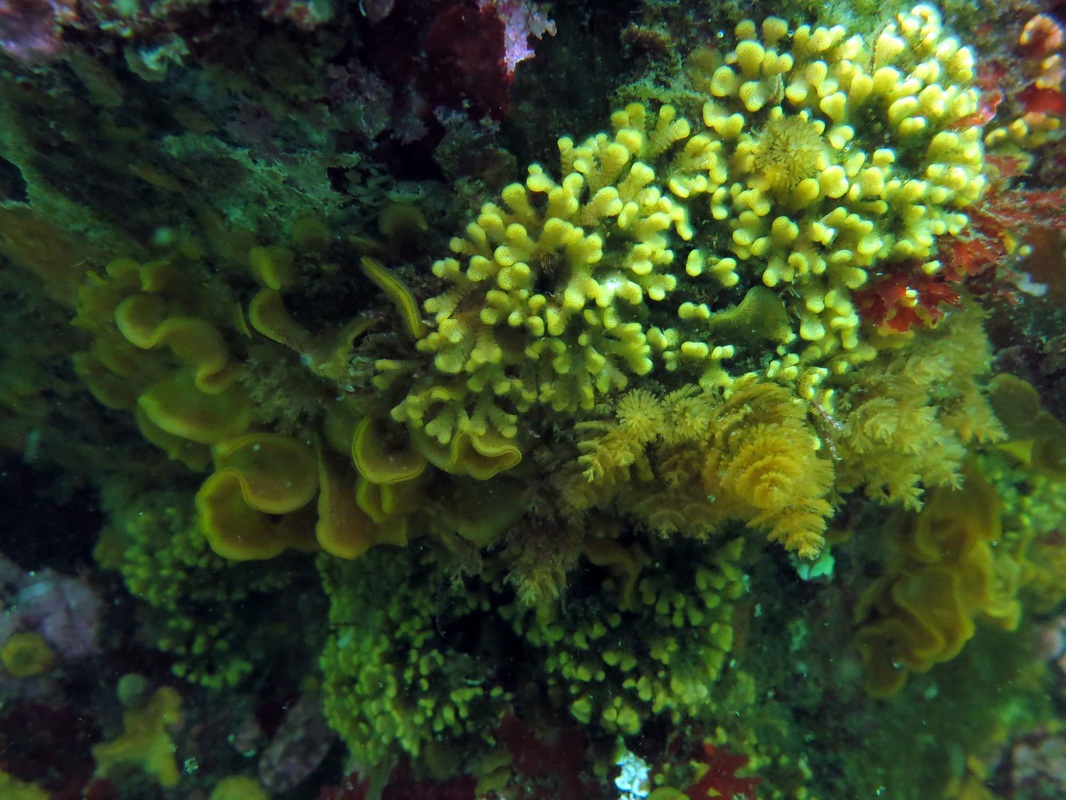Spiral bryozoan • Bugula californica
Bugula californica is the clusters of orangey-brown cone or tree shapes at centre right. Also pictured here are Hippodiplosia insculpta (flattened, wavy-edged, and orange at centre left) and Heteropora pacifica (yellowish and lobed, at top right). Photo by Jenn Burt.
Identification
This upright bryozoan forms miniature conifer-shaped colonies. It has a spiral growth pattern, with whorled branches branching off a main axis (not a distinct stalk, however) and decreasing in length near the colony tip. These branches are somewhat flexible, as the bryozoan is only light calcified. It is white to tan in colour, though during sexual reproduction sections of the colony may turn orange. The little 'trees' reach 7.5 cm tall and tend to grow in clusters.
Habitat & Range
The spiral bryozoan grows on rock, docks, and other hard substrates in the subtidal to a maximum of 400 m deep, but is most common at depths less than 60 or 70 m. Its range extends from BC south to the Galapagos Islands, and is also found along shores in Hawaii.
Similar Species
Other Bugula species may have a similarly bushy growth, such as B. pacifica, but their branches do not grow in spiral whorls.
Intriguing Info
This bryozoan falls prey to the clown nudibranch (Triopha catalinae).
This upright bryozoan forms miniature conifer-shaped colonies. It has a spiral growth pattern, with whorled branches branching off a main axis (not a distinct stalk, however) and decreasing in length near the colony tip. These branches are somewhat flexible, as the bryozoan is only light calcified. It is white to tan in colour, though during sexual reproduction sections of the colony may turn orange. The little 'trees' reach 7.5 cm tall and tend to grow in clusters.
Habitat & Range
The spiral bryozoan grows on rock, docks, and other hard substrates in the subtidal to a maximum of 400 m deep, but is most common at depths less than 60 or 70 m. Its range extends from BC south to the Galapagos Islands, and is also found along shores in Hawaii.
Similar Species
Other Bugula species may have a similarly bushy growth, such as B. pacifica, but their branches do not grow in spiral whorls.
Intriguing Info
This bryozoan falls prey to the clown nudibranch (Triopha catalinae).
References
Cowles, D. (2012). Bugula californica Robertson, 1905. Invertebrates of the Salish Sea. Rosario Beach Marine Laboratory. Accessed 13/10/2015.
Lamb, A., and Hanby, B. (2005). Marine Life of the Pacific Northwest [electronic version]. Madeira Park, BC: Harbour Publishing.
Authors and editors of page
Kelly Fretwell (2015).
Cowles, D. (2012). Bugula californica Robertson, 1905. Invertebrates of the Salish Sea. Rosario Beach Marine Laboratory. Accessed 13/10/2015.
Lamb, A., and Hanby, B. (2005). Marine Life of the Pacific Northwest [electronic version]. Madeira Park, BC: Harbour Publishing.
Authors and editors of page
Kelly Fretwell (2015).




